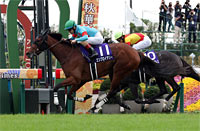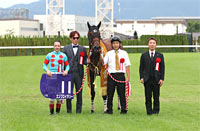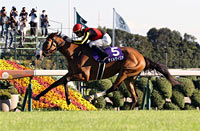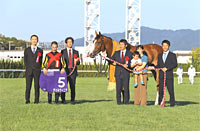Shuka Sho (G1) - Data Analysis
Note: “1-win,” “2-win,” and “3-win” classes correspond to the previous “5 million yen-or-less,” “10 million yen-or-less,” and “16 million yen-or-less” classes.
Final leg of the Triple Crown determines autumn’s champion three-year-old filly
Following the Oka Sho (Japanese 1000 Guineas) and Yushun Himba (Japanese Oaks) in spring, the Triple Crown for three-year-old fillies concludes with the Shuka Sho. Over the last 10 years, the three races making up the Triple Crown have been won by the same runner on three occasions, and this year’s Shuka Sho is likely to attract attention as a similar dynamic may play out. In addition, looking at performances by the Top 2 finishers over the last 10 years in terms of favoritism, we find that 18 of the 20 runners were backed as 5th favorite or higher, suggesting highly favored horses perform well. Let’s now look for some trends in results over the last 10 years.
Runners that have entered a race since the summer have an edge
Looking at performances by runners over the last 10 years in terms of their previous race, we observe that after excluding one runner that had previously contested a 3-win (previous 16 million yen-or-less) class race, only the runners that had entered the Hokkaido Shimbun Hai Queen Stakes, Kansai Telecasting Corp Sho Rose Stakes (Shuka Sho Trial), or the Shion Stakes (Shuka Sho Trial) (since upgrade to G3 race in 2016) in their previous race achieved a Top 3 ratio of over 20%. Although the last two Shuka Sho winners came straight from the Japanese Oaks, these were the only two runners in this group to finish in the Top 3. This basically suggests that runners that have entered a race since the summer have an edge. [Table 1]
[Table 1] Performance by previous race (last 10 years)
| Previous race |
Performance
[1st-2nd-3rd-4th or lower] |
Win ratio |
Top 2 ratio |
Top 3 ratio |
| Yushun Himba (Japanese Oaks) |
2-0-0-11 |
15.4% |
15.4% |
15.4% |
| Kansai Telecasting Corp Sho Rose Stakes (Shuka Sho Trial) |
4-6-7-55 |
5.6% |
13.9% |
23.6% |
| Hokkaido Shimbun Hai Queen Stakes |
1-0-1-5 |
14.3% |
14.3% |
28.6% |
| Shion Stakes (Shuka Sho Trial) (G3) |
2-2-0-15 |
10.5% |
21.1% |
21.1% |
| Shion Stakes (Shuka Sho Trial) (open-class) |
1-0-0-27 |
3.6% |
3.6% |
3.6% |
| 3-win class (previous 16 million yen-or-less class) |
0-0-1-0 |
0% |
0% |
100% |
| 2-win class (previous 10 million yen-or-less class) |
0-2-0-18 |
0% |
10.0% |
10.0% |
| 1-win class (previous 5 million yen-or-less) |
0-0-1-9 |
0% |
0% |
10.0% |
| Other race |
0-0-0-7 |
0% |
0% |
0% |
Note: The Shion Stakes (Shuka Sho Trial) was held as an open-class race until 2015, and upgraded to G3 status in 2016.
Check performance in last two races
Looking at performances by runners over the last 10 years in terms of the highest time difference with the winner of a race they lost within their last two outings, we note that runners with a time difference of “0.4s or less” had the highest Top 3 ratios, followed by runners that “won their last two races.” Success ratios tend to decline as the time difference increases, so we should raise our expectations of runners that have either won their last two races or finished with a low time difference with the winner in such races. [Table 2]
[Table 2] Performance by highest time difference with winner in last two races (last 10 years)
| Highest time difference |
Performance
[1st-2nd-3rd-4th or lower] |
Win ratio |
Top 2 ratio |
Top 3 ratio |
| Won last two races |
4-2-0-19 |
16.0% |
24.0% |
24.0% |
| 0.4s or less |
6-2-4-29 |
14.6% |
19.5% |
29.3% |
| 0.5s-1.0s |
0-5-3-37 |
0% |
11.1% |
17.8% |
| 1.1s or more |
0-1-3-62 |
0% |
1.5% |
6.1% |
Focus on position when passing 4th corner in previous race
Looking at performances by runners over the last 10 years in terms of their position when passing the 4th corner in their previous race, we find that runners that were positioned “5th-9th” achieved the highest Top 3 ratio, and that the same group made up 16 of the 30 Top 3 finishers. The other groups all had Top 3 ratios of around 13%, one notch below the group that was positioned “5th-9th.” When comparing the conditions of the previous race, we should focus on runners positioned in the middle of the pack when passing the 4th corner. [Table 3]
[Table 3] Performance by position when passing 4th corner in previous race (last 10 years)
| Position when passing 4th corner in previous race |
Performance
[1st-2nd-3rd-4th or lower] |
Win ratio |
Top 2 ratio |
Top 3 ratio |
| Leader |
0-1-2-19 |
0% |
4.5% |
13.6% |
| 2nd-4th |
2-2-3-47 |
3.7% |
7.4% |
13.0% |
| 5th-9th |
5-6-5-53 |
7.2% |
15.9% |
23.2% |
| 10th or below |
3-1-0-27 |
9.7% |
12.9% |
12.9% |
Note: Excluding runners that contested a NAR race last time out.
Strong performance by runners with favorable record in graded turf race held in same year
Looking at performances by runners over the last 10 years in terms of their highest finish in a graded turf race held in the same year, we observe that 26 of the 30 Top 3 finishers had finished in the Top 3 of such a race. Runners that won such a race achieved the highest Win ratio, Top 2 ratio, and Top 3 ratio. In other words, we should focus on runners that have performed well in a graded turf race in the same year. [Table 4]
[Table 4] Performance by highest finish in graded turf race in same year (last 10 years)
| Highest finish |
Performance
[1st-2nd-3rd-4th or lower] |
Win ratio |
Top 2 ratio |
Top 3 ratio |
| 1st |
8-4-4-34 |
16.0% |
24.0% |
32.0% |
| 2nd |
1-3-2-29 |
2.9% |
11.4% |
17.1% |
| 3rd |
0-1-3-11 |
0% |
6.7% |
26.7% |
| 4th |
0-0-0-9 |
0% |
0% |
0% |
| 5th |
1-0-0-8 |
11.1% |
11.1% |
11.1% |
| 6th or lower |
0-0-0-32 |
0% |
0% |
0% |
| No graded race entered in same year |
0-2-1-24 |
0% |
7.4% |
11.1% |
Seek out the winner!
Watch favoritism in most recent graded race
Looking at performances by the last 10 winners in terms of favoritism in their most recently contested graded race, we note that seven out of the 10 runners had been backed as 1st favorite in such a race, while the remaining three runners had been backed as 2nd-4th. This suggests that high favoritism in the most recently contested graded race has been an accurate indicator of runners’ actual performance. To identify potential winners, we should therefore check runners’ favoritism in their most recently contested graded race. [Table 5]
[Table 5] Winners’ favoritism in most recently contested graded race (last 10 years)
| Year |
Winner |
Favoritism in most recently
contested graded race |
| 2010 |
Apapane |
1st favorite |
| 2011 |
Aventura |
1st favorite |
| 2012 |
Gentildonna |
1st favorite |
| 2013 |
Meisho Mambo |
4th favorite |
| 2014 |
Shonan Pandora |
1st favorite |
| 2015 |
Mikki Queen |
1st favorite |
| 2016 |
Vivlos |
3rd favorite |
| 2017 |
Deirdre |
1st favorite |
| 2018 |
Almond Eye |
1st favorite |
| 2019 |
Chrono Genesis |
2nd favorite |
(Michio Kawano)
|


















